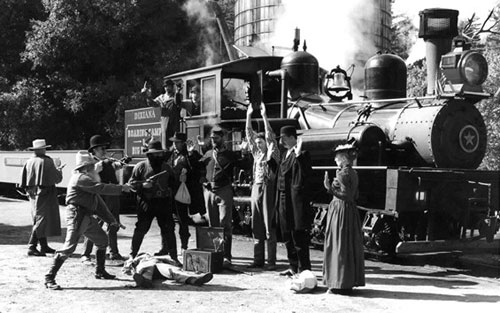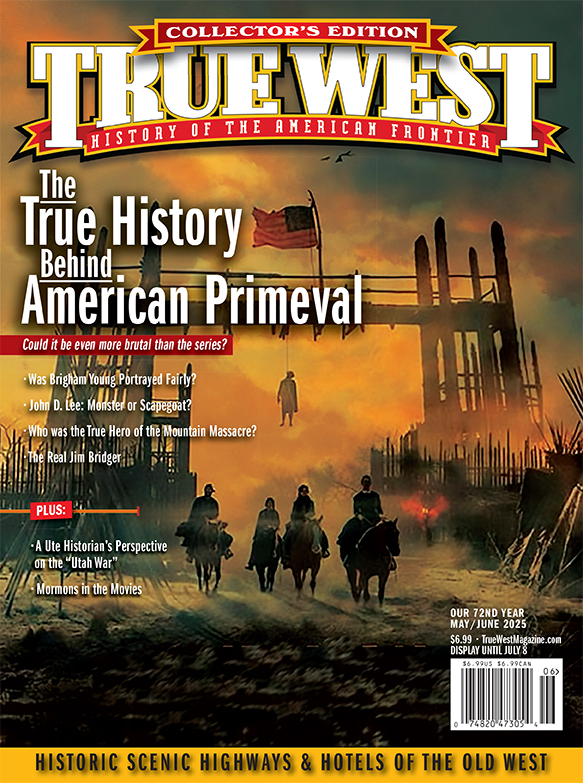
On the evening of April 27th, 1887 southern Arizona’s only passenger train, the Sunset Express, was making its run toward Tucson. The train was running a few minutes behind schedule so the engineer, “Colonel” Bill Harper gave her a little more steam to make up time. About 20 miles east of Tucson at Cienega Canyon the yellow streak from the headlight picked up a figure standing on the track waving a red lantern. About that time the big drive wheels ran over a torpedo. The bomb-like sound served as a warning of trouble further up the line. Colonel Harper slammed on the brakes and stopped just before crashing into some upraised railroad ties jammed between the tracks.
Suddenly, out of the darkness, rifle shots cracked and several holes appeared in the engine’s boiler. Two masked men stepped out of the darkness and ordered the engineer to step down off the train. They took him back to the express car and told him to have the Wells Fargo express messenger open the safe then unlock the door and get out.
“Or what?” the stubborn engineer asked.
“Or we blow it up,” one of the bandits replied, holding up a stick of dynamite.
Inside the express car, messenger Charlie Smith heard the conversation and opened the safe, took out some $5,000 and stuffed it in the cold, pot-bellied stove. The money safely hidden, Smith unlocked the door and jumped out.
The robbers, members of the notorious Doc Smart gang, climbed in the express car and found only a few scattered bills in the safe. Disappointed, they gathered up the meager haul.
Meanwhile, Harper was escorted back to cut the passenger cars from the mail and express car. He was then taken back and ordered to move the engine and two cars ahead a few yards.
After receiving a few hurried instructions on how to run a locomotive from Harper they had him get the engine rolling then made him jump off. The engine chuffed off towards Tucson with the outlaws on board.
Later that night when the Sunset Express failed to show a relief train was sent out from Tucson. About 15 miles east of the Old Pueblo they discovered the abandoned engine and the ransacked express car. A few miles further down the track they found the anxious crew waiting by the passenger cars.
The next day a posse, led by Tohono O’odham trackers went to where the engine was found and attempted to pick up the trail of the desperadoes. They circled further and further away from the engine in a futile attempt to cut the trail. It was as if the entire gang levitated into space.
Clever escape however the outlaws had been hoodwinked by Charlie Smith, the Wells Fargo messenger who’d hidden the loot in the stove. The newspapers made a big deal out of it and Smith became a local celebrity.
On August 10th the gang struck again. Same location; same train and the same Wells Fargo messenger, Charlie Smith. This time the engineer couldn’t stop in time and the engine jumped the tracks and flipped over on its side on the edge of a steep embankment. Out in the darkness the outlaws opened fire. One bullet passed so close under the nose of fireman R. T. Bradford it burned off part of his mustache. The engineer, Jim Guthrie, hopped out of the prostrate locomotive and tumbled over the steep bluff landing several feet below in the top of a mesquite tree.
Doc Smart and his boys weren’t taking any chances this time. When Smith refused to open the door, a stick of dynamite took care of it. Inside was their nemesis, Charlie the messenger slightly shaken from the blast.
One of the robbers pointed the business end of his six shooter at poor Charlie and hissed,
“Smitty, that stove racket don’t go this time.”
No doubt the outlaws had read the newspaper stories extolling about how Charlie had outwitted them in the previous robbery.
A posse picked up their trail this time and followed it into the Rincon Mountains where they came upon an abandoned sack containing a thousand dollars in Mexican silver. Nearby was a cave where the outlaws had used as a hideout. Today that cave is a popular tourist attraction known as Colossal Cave.
The gang got away clean that time with $3,000 in their pockets and while lawmen scoured the Arizona Territory, the outlaws were living it up in El Paso.
Things had gone so well the last time, two of the outlaws decided to rob the old SP once again, this time outside El Paso. Inside the express car was another messenger named Smith. This one greeted the train robbers with a six gun and a Wells Fargo 10 gauge shotgun. When the smoke cleared two of them, Kid Smith, no relation to either of the messengers, and Dick Meyers were dead on the ground.
Smart detective work enabled lawmen in El Paso to locate the boarding house where the two outlaws were staying. Soon they rounded up the rest of the gang including Doc Smart.
Doc was tried and given a life sentence for his part in the three train robberies. Somebody slipped him a pistol and he decided to take his own life. He put the pistol to his head and fired three shots but the soft lead collided with his hard head and all Doc got out it was a bad headache.
It wasn’t until after the gang was in jail that lawmen were finally able to clear up the mystery of how they’d managed to vanish into thin air in the desert south of Tucson. One of the gang spilled the beans and it was really quite simple. They rode the engine into the outskirts of Tucson, put it in reverse, then jumped off and walked into town. The engine, with its perforated belly leaking steam, backed down the tracks some ten miles where it was found—-with no tell-tale tracks to follow.
Thanks to an accomplice who worked for the railroad, Doc and the boys left Tucson riding comfortably in an SP caboose back to El Paso.





